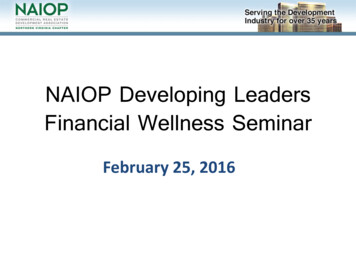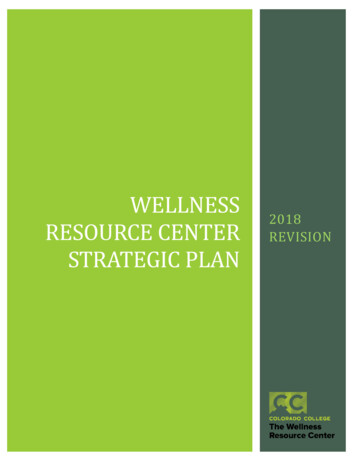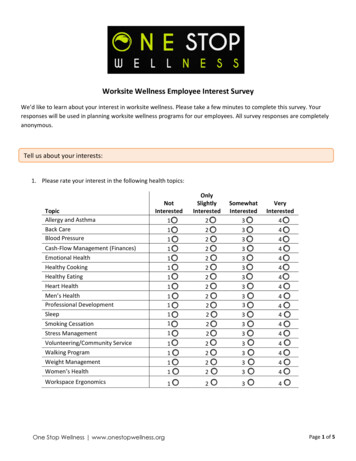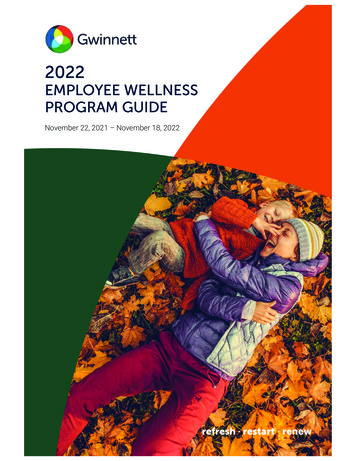
Transcription
NAIOP Developing LeadersFinancial Wellness SeminarFebruary 25, 2016
Savings Plan2
Fundamentals Setting goals is the first step to achievingthem Goals must be “SMART”– S Specific– M Measurable– A Attainable– R Realistic– T Timely3
Paying off Debt vs. Investing1. Pay off manageable low-balance debt firstto create cashflow2. Pay off higher-interest rate debt, then moveto lower-interest rate debt3. Once short-term debt is managed, beginlong-term savings/investments (i.e.,retirement)4. Pay off long-term debt (i.e., mortgage)4
Find Unnecessary Expenses WithinYour Budget:Item5CostMonthly SavingsVending Snacks 1.50 (3x week) 18.00Restaurant Coffee 2.50 (7x week) 70.00Restaurant Lunch 6.50 (5x week) 130.00
BUDGET6
What Should You Be Spending? Here are some budget percentage guidelines toconsider. Remember, these are after-tax amounts:Housing: 25% to 35%Transport: 5% to 15%Food (groceries and dining): 10% to 15%Personal care (including clothing): 5% to 10%***Forbes online7
What Should You Be Spending?Health care (including insurance premiums): 10% to 15%Loan repayment (excluding car payments): 7% to 15%Utilities: 4% to 7%Entertainment: 1% to 5%***Forbes online8
Savings Develop an emergency nest egg 3 – 6months of savings. Try to allocate 10% ofearnings each month until it is built up.***Forbes online9
Sample ClientSurvivor Needs AnalysisFebruary 2016Assumed Gross Rate of ReturnAssumed Net Rate of ReturnAssumed Rate of InflationAssumed Blended Tax Bracket5.00%3.50%3.00%30.00%Income Protection AnalysisYearSurvivingSpouse's AgePrincipalAssumed Mortgage: 30 year fixed; 4%Liability AnalysisAsset AnalysisGap AnalysisIncomeEducationIncomeMortgageTotalExisting LifeInsuranceNon- QualifiedInvestmentsTotalSurplus/Deficit136 4,198,543 150,000 500,000 4,198,543 650,000 5,348,543 0 500,000 500,001( 4,848,542)237 4,190,242 154,500 500,000 4,190,242 639,524 5,329,766 0 517,500 517,501( 4,812,265)338 4,176,993 159,135 500,000 4,176,993 5,292,287 0 535,613 535,614( 4,756,674)439 4,158,483 163,909 500,000 4,158,483 615,294 602,433 5,260,917 0 554,359 554,360( 4,706,556)540 4,134,384 168,826 500,000 4,134,384 589,049 5,223,433 0 573,762 573,763( 4,649,670)641 4,104,353 173,891 500,000 4,104,353 575,119 5,179,471 0 593,843 593,844( 4,585,627)742 4,068,028 179,108 500,000 4,068,028 560,621 5,128,649 0 614,628 614,629( 4,514,020)843 4,025,032 184,481 500,000 4,025,032 545,533 5,070,565 0 636,140 636,141( 4,434,424)944 3,974,970 190,016 500,000 3,974,970 529,830 5,004,800 0 658,405 658,406( 4,346,394)1045 3,917,428 195,716 500,000 3,917,428 4,930,915 0 681,449 681,450( 4,249,465)1146 3,851,972 201,587 500,000 3,851,972 513,487 478,777 4,830,749 0 705,299 705,301( 4,125,449)1247 3,778,148 207,635 500,000 3,778,148 460,355 4,738,503 0 729,985 729,986( 4,008,516)1348 3,695,481 213,864 500,000 3,695,481 441,182 4,636,662 0 755,534 755,536( 3,881,127)1449 3,603,473 220,280 500,000 3,603,473 421,227 4,524,701 0 781,978 781,980( 3,742,721)1550 3,501,605 226,888 500,000 3,501,605 4,402,065 0 809,347 809,349( 3,592,716)1651 3,389,332 233,695 500,000 3,389,332 400,460 378,847 4,268,178 0 837,674 837,676( 3,430,502)1752 3,266,084 240,706 500,000 3,266,084 356,353 4,122,436 0 866,993 866,995( 3,255,442)1853 3,131,266 247,927 500,000 3,131,266 332,942 3,964,208 0 897,338 897,340( 3,066,869)1954 2,984,256 255,365 500,000 2,984,256 308,578 3,792,834 0 928,745 928,746( 2,864,087)2055 2,824,402 263,026 500,000 2,824,402 283,221 3,607,623 0 961,251 961,253( 2,646,371)2156 2,651,024 270,917 500,000 2,651,024 3,407,856 0 994,894 994,896( 2,412,959)2257 2,463,411 279,044 500,000 2,463,411 256,832 229,366 3,192,778 0 1,029,716 1,029,718( 2,163,060)2358 2,260,820 287,416 500,000 2,260,820 200,782 2,961,602 0 1,065,756 1,065,758( 1,895,845)2459 2,042,474 296,038 500,000 2,042,474 171,034 2,713,508 0 1,103,057 1,103,059( 1,610,448)2560 1,807,561 304,919 500,000 1,807,561 140,073 2,447,634 0 1,141,664 1,141,667( 1,305,968)2661 1,555,234 314,067 0 1,555,234 107,851 1,663,086 0 1,181,622 1,181,625( 481,461)2762 1,284,608 323,489 0 1,284,608 74,317 1,358,925 0 1,222,979 1,222,982( 135,943)2863 994,759 333,193 0 994,759 39,416 1,034,175 0 1,265,784 1,265,786 231,6112964 684,720 343,189 0 684,720 687,813 0 1,310,086 1,310,089 622,2753065 353,485 353,485 0 353,485 3,093 0 353,485 0 1,355,939 1,355,942 1,002,45710Matthew Friedson, Senior Advisor, mfriedson@gwellc.com, 301-656-0660 x307Greenberg, Wexler & Eig, LLC, 7316 Wisconsin Ave, Suite 230, Bethesda, MD 20814, www.gwellc.com
Basic Estate Planning Documents Last Will and Testament Revocable Living Trust Advanced Medical Directive (whichincludes a Living Will) Durable General Power of Attorney11
INVESTMENT BASICS12
Things to Consider How do you choose a planner/advisor? Start with a financial plan – how much tosave. 401k versus outside investments Mutual funds versus stocks 529 plans13
Long-Term Investing Basics Know your ‘Investment Horizon’ – when are youactually going to need this money? Ignore short-term trends, focus on the long-term Pick a strategy and stick to it All investments go through cycles Never try to time the market or chase the ‘hot stocktip’14
Terms to Know Dollar Cost Averaging – contributing the same amount of money at regularintervals– Minimizes effect of market fluctuation– Buy more when the market is low, less when it is high Asset Allocation – balancing risk vs reward based on an individual’s risktolerance and investment horizon Risk Tolerance – how much volatility can you withstand in your investments Investment Horizon – length of time your money is invested15
Keep Short-Term Trends in Perspective16
Stay the Course When Markets Get Choppy17
Issues to Consider in Estate Planning 18Estate taxes – federal and stateCare of minor childrenChildren with disabilities or other special needsChildren with financial, substance abuse, or maritalproblemsBlended families – second spouses and children fromprevious marriagesCompetency issues with advanced ageProperty in multiple states and/or other countriesMethods of avoiding probate
DisclosuresBronfman E.L. Rothschild, LP is a registered investment advisor.Certified Financial Planner Board of Standards, Inc. owns the certification marks CFP , Certified Financial Planner and federallyregistered CFP (with flame design) in the U.S., which it awards to individuals who successfully complete CFP Board's initial andongoing certification requirements.Bronfman E.L. Rothschild, LP is a registered investment advisor. Securities, when offered, are offered through Baker Tilly Capital,LLC, member of FINRA and SIPC; Office of Supervisory Jurisdiction located at 10 Terrace Court, Madison, WI 53718, phone800.362.7301. Bronfman E.L. Rothschild, LP and Baker Tilly Capital, LLC are not affiliated.This publication should not be viewed as a recommendation, an offer to sell, or a solicitation of an offer to buy a particularsecurity or service. The commentary provided is for informational purposes only and should not be relied on for accounting, legal,tax, or investment advice. Financial information is from third-party sources. While such information is believed to be reliable, it isnot verified or guaranteed. Performance of any indexes is provided for reference and competitive purposes only without factoringany fees, commissions and other charges. Individual results achieved by investors will be different from those of the indexes.Indexes are unmanaged; one cannot invest directly into an index. The views and opinions expressed are those of Bronfman E.L.Rothschild, and they are subject to change at any time. Past performance does not imply or guarantee future results. Investing insecurities involves risks, including possible loss of principal. Diversification cannot assure a profit or guarantee against a loss.Investing involves other forms of risk that are not described here. For that reason, you should contact an investment professionalbefore acting on any information in this publication. 2015 Bronfman E.L. Rothschild19
1. Pay off manageable low -balance debt first to create cashflow 2. Pay off higher -interest rate debt, then move to lower-interest rate debt 3. Once short-term debt is managed, begin long-term savings/investments (i.e., retirement) 4. Pay off long -term debt (i.e., mortgage) 4 Find Unnecessary Expenses Within Your Budget: Item Cost 6










